Intro: A reverential visit to one of World War II’s
most haunting and impressive sites.
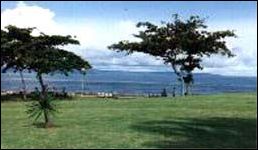 Also see:
Also see:
Gay Philippines Stories
Gay Philippines News & Reports 2001 to present
Gay Philippines Photo Galleries
By Richard Ammon
September 1998
The most haunting aspect of history is the echoing silence that enfolds epic events long after their final heave.
Under the clear azure waters of the white sand beaches of Palo, on Leyte Island in the Philippines, lie the encrusted hulks of bombed warships that sank to the deep along with the lives of thousands of soldiers and sailors from warring nations during WWII.
Today, as the plumes of cumulous clouds gently blow across the horizon of this central island, I stand and look eastward across the serenity of Leyte Gulf, my footsteps momentarily imprinted on the soft sand once stained red with young blood.
This is the infamous ‘Red Beach’. It lies a few miles south of the town of Tacloban, the present capital of Leyte and the first town liberated by the returning American forces in 1944.
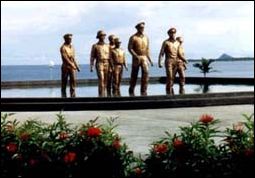 I stood near the ‘Leyte Landing’, a dramatic memorial to those famous events. Douglas MacArthur, cast in bigger-than-life bronze, wades ashore escorted by Philippine President Osmeno and high-ranking staff members. Their arrival signaled the Japanese retreat from its cruel ravage and aggressive torment across Southeast Asia.
I stood near the ‘Leyte Landing’, a dramatic memorial to those famous events. Douglas MacArthur, cast in bigger-than-life bronze, wades ashore escorted by Philippine President Osmeno and high-ranking staff members. Their arrival signaled the Japanese retreat from its cruel ravage and aggressive torment across Southeast Asia.
What happened here that wrested the Philippines from the Japanese empire is remembered now by very few survivors; most others recall it from books and films. The last gasp of dying sailors and soldiers, the deafening blast of exploding artilleries, the screaming terror of kamikaze planes and the wailing of mothers for their dead sons–few can see or hear these in their memories now.
As I stood by the same shallow waters, I listened to the rustle of the gently lapping waves of the gulf. The splashing water was the only audible reminder today as I contemplated the impressive monument that holds such enormous meaning and heritage.
The memorial consists of seven bronze double-life-size figures. MacArthur, taller than the others to create perspective, in the lead of President Osmena, Generals Kincaid, Romolo and Sutherland followed by two staff members. All the statues stand in a glassy shallow pond of water just fifty feet from the deadly landing site.
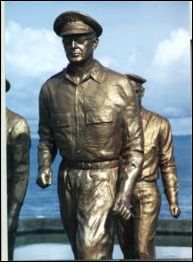 A smooth green-grass park of several acres shaded by tall palms surrounds the statues and pond. On this particular day, a hot gentle breeze barely rustles the leaves.
A smooth green-grass park of several acres shaded by tall palms surrounds the statues and pond. On this particular day, a hot gentle breeze barely rustles the leaves.
In his biography of MacArthur, William Manchester writes: "At daybreak (October 20, 1944) the U.S. warships opened fire on the beach…the shore was dimly visible through an ominous, rising haze shot with yellow flashes; inland, white phosphorus crumps were bursting among the thick, ripe underbrush of the hills. The light of the rising sun spread rapidly across the smooth green water of the gulf…
"The General reappeared on deck watching the diving enemy planes zooming overhead; then he looked shoreward, where the sand spits, palms, thick underbrush, and tiny grass huts were obscured by the bursts of exploding shells and tall columns of black smoke…
"Later as the landing troops established a beachhead, during the third assault, MacArthur took a landing craft toward the shore which went aground short of the water’s edge. MacArthur ordered the barge ramp lowered , stepped off into knee-deep brine, and splashed forty wet strides to the beach and into one of history’s most famous photo ops. MacArthur later scrawled a letter to President Roosevelt: ‘This note is written from the beach near Tacloban where we have just landed. It will be the first letter from the freed Philippines…’ "
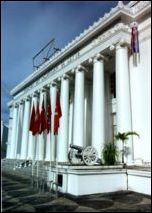 Later that day the General, aware of his messianic role in this ravaged country, issued his famous radio broadcast in a sopping downpour: "People of the Philippines, I have returned…" It was spoken from the white-columned capitol building in Tacloban which served as the General’s HQ and is still in use today.
Later that day the General, aware of his messianic role in this ravaged country, issued his famous radio broadcast in a sopping downpour: "People of the Philippines, I have returned…" It was spoken from the white-columned capitol building in Tacloban which served as the General’s HQ and is still in use today.
The naval Battle of Leyte under Admirals Nimitz, Halsey, Oldendorf and Kincaid assured MacArthur’s recapture of the Philippines with an army of over 200,000 troops. It was one of the greatest and most brutal sea battles and beach landings of all time.
With their combined fleet strength of 282 ships, they humiliated the voracious and deadly Japanese ‘dragon’ by sinking four of their aircraft carriers, three battle ships, six heavy cruisers, three light cruisers, and eight destroyers. Manchester observes: "Except for sacrificial kamikaze fliers, who made their debut in this battle, Japanese air and naval strength would never again be serious instruments in the war."
These quotes are from a tattered paperback edition of the biography I happened to be reading when I left the shores of America for a long Asian trip. As serendipity would have it, I landed in Cebu City on the next island over from Leyte. It was my first encounter with the Visayas, the central islands of the Philippines.
Manchester’s book, ‘American Caesar’, described on page seventy-six that General Douglas MacArthur had once been stationed in Tacloban as a young officer. He returned forty years later a conquering hero. On a map I realized that Tacloban was only a couple of hours way from Cebu, so I headed for a rendezvous with history.
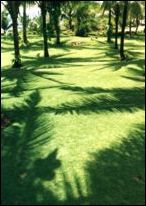 I too landed in Leyte by boat, except mine was a catamaran ferry with air-conditioned ‘business class’, sandwiches and soft drinks. Christmas carols (in September?) played over the loudspeaker, and, later, a violent American video rankled the ambiance of my cabin.
I too landed in Leyte by boat, except mine was a catamaran ferry with air-conditioned ‘business class’, sandwiches and soft drinks. Christmas carols (in September?) played over the loudspeaker, and, later, a violent American video rankled the ambiance of my cabin.
Landing in Ormac on the south west side of Leyte Island, a taxi took me for the overland drive of almost two hours to arrive at Palo’s famous Red Beach, a couple of miles south of Tacloban.
Arriving in an air-conditioned taxi felt a bit inappropriate as I approached MacArthur Park, given the harsh historical condition that prevailed virtually fifty-four years ago to the day.
The blood bath on that day can perhaps best be recalled from the opening scenes of the 1999 film ‘Saving Private Ryan’ during which the viewer is subjected to the ripping terror and ghastly carnage of beach-landing warfare.
The Battle of Leyte Gulf was one of the pivotal invasion/slaughters of history that changed the course of modern civilization. Young flesh was thrown directly in harm’s way; many died and many survived to pave the way for the defeat of Japan. It also opened the way for the brilliant narcissist MacArthur to wade ashore on the third assault, pants neatly creased, sun glasses in place, head high for the photographers and very aware of his messianic role at that vortex of history.
I was very impressed. It is one of those places that echo with reverence and enormous silence, considering all that passed here.
One’s opinions of the personalities of the characters matter little. This is one of those places where history gathered up the soul of man and squeezed it within an inch of its freedom.
At Hiroshima I had the same deep impression of the stunningly cruel magnificence of the human mind.
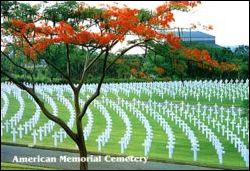 History’s most haunting voice is silence, I think. There is no more debate, no more blood, no more of those heroes–just quietness disturbed only by the eternal lapping of the waves as they wash in from the infinite blue of the sea. Under the water’s surface are the stolen lives of young men whom I cannot see–and it is difficult to remember who they were.
History’s most haunting voice is silence, I think. There is no more debate, no more blood, no more of those heroes–just quietness disturbed only by the eternal lapping of the waves as they wash in from the infinite blue of the sea. Under the water’s surface are the stolen lives of young men whom I cannot see–and it is difficult to remember who they were.
Anonymity can lead to forgetting and indifference–and blunted memories. Such indifference and silence can lead most of us to learn very little from history. In forgetting the past and ignoring it’s wisdom, the same discrimination and hostility which evoked war is perpetuated among a species of beings who forget that we have much more in common and fewer differences among us.
















